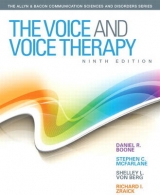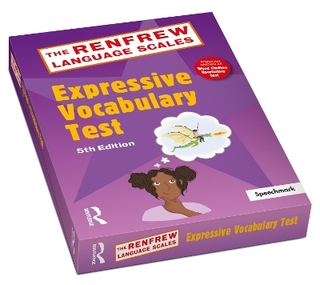
The Voice and Voice Therapy
Pearson
978-0-205-60953-6 (ISBN)
- Titel erscheint in neuer Auflage
- Artikel merken
Still the most complete voice treatment textbook available, The Voice and Voice Therapy boasts the most up-to-date evidence-based practice and outcomes assessment and voice therapy facilitation techniques available today, while the comprehensive companion DVD illustrates voice problems in children and adults, as well as methods of relevant therapy, enabling students to see and hear what they are reading about.
The eighth edition divides voice disorders into four causal areas (psychogenic, muscle tension, organic, and neurogenic), with each identified issue presented with particular evaluation procedures and strategies. The text also covers disorders that are not often addressed in other books–including sulcus vocalis, muscle tension dysphonia, and paradoxial vocal fold dysfunction.
Daniel R. Boone celebrates his 55th year as a speech-language pathologist with the publishing of this eighth edition of The Voice and Voice Therapy. Dr. Boone has held professorships over the years at Case Western Reserve University, University of Kansas Medical Center, University of Denver, and the University of Arizona (where he is now a professor emeritus). Dr. Boone is a former president of the American Speech-Language-Hearing As-sociation and holds both a fellowship and the honors of that organization. He is the author of over 100 publications and is well known nationally and interna-tionally for his many lecture and workshop presentations. Perhaps Dr. Boone is best known for his love of his students and turning them on to the excitement of clinical voice practice. Stephen C. McFarlane is a professor emeritus at the School of Medicine at the University of Nevada, Reno. He received ASHA honors in 1999. He received both his B.S. and M.S. from Portland State University and his Ph.D. from the University of Washington. Dr. McFarlane has a long history of research interests in the area of voice disorders. Study of the outcomes from voice therapy and the development of new treatment techniques is of particular interest. He has been published in dozens of books and journals, among them Seminars in Speech and Language; American Journal of Speech Language Pathology, Phonoscope, and Current Opinion in Otolaryngology & Head and Neck Surgery. Shelley L. Von Berg teaches, practices, and researches in the areas of voice, dysphagia, and motor speech disorders in adults and children at the Department of Communication Sciences and Disorders at California State University, Chico. She earned her M.S. and Ph.D. from the School of Medicine at the University of Nevada, Reno. She has presented on the assessment and intervention of neurogenic speech-language disorders nationally and abroad. Dr. Von Berg has been published in the ASHA Leader Series; Unmasking Voice Disorders; Language, Speech, and Hearing Services in Schools; Current Opinion in Otolaryngology & Head and Neck Surgery; and Cleft Palate-Craniofacial Journal. Richard I. Zraick is an associate professor in the Department of Audiology and Speech Pathology at the University of Arkansas for Medical Sciences and the University of Arkansas at Little Rock. His research interests include voice disorders, neurologically-based communication disorders, adult speech disorders, and clinical skills training for speech-language pathology students.
Contents to the DVD xi
Preface xii
1 The Voice and Voice Therapy 1
The Biological Function of the Larynx 2
The Emotional Function of the Larynx 3
The Linguistic Function of the Voice 4
Voice Disorders in the Normal Population 5
Kinds of Voice Disorders 6
2 The Normal Voice 14
Normal Aspects of Voice 15
Normal Processes of Voice Production 15
Respiration 16
Anatomy of Phonation 25
Principles of Phonation 41
Resonance 48
Structures of Resonance 48
Mechanism of Resonance 49
Summary 53
Thought Questions 53
Organic Voice Disorders 8
Neurogenic Voice Disorders 8
Psychogenic Voice Disorders 9
Muscle Tension Dysphonia 9
Management and Therapy for Voice Disorders 10
Summary 13
Thought Questions 13
3 Organic Voice Disorders 54
Cancer 56
Congenital Abnormalities 56
Laryngomalacia 56
Subglottal Stenosis 57
Tracheoesophageal Fistulas and Esophageal Atresia 57
Contact Ulcers (Granulomas) 58
Cysts 61
Endocrine Changes 61
Hemangioma 63
Hyperkeratosis 63
Infectious Laryngitis 64
Laryngectomy 64
Leukoplakia 65
Papilloma 66
Pubertal Changes 68
Reflux 69
Sulcus Vocalis 71
Webbing 73
Summary 74
Thought Questions 74
4 Neurogenic Voice Disorders 76
A Working View of the Nervous System 77
The Central Nervous System (CNS), the Cortex, and Its Projections 77
Pyramidal and Extrapyramidal Tracts 78
The Peripheral Nervous System (PNS) 82
Flaccid Dysarthria 87
Vocal Fold Paralysis 87
Myasthenia Gravis 92
Guillain—Barré 93
Unilateral Upper Motor Neuron Dysarthria (UUMND) 93
Spastic Dysarthria 94
Hypokinetic Dysarthria 95
Parkinson’s Disease 95
Hyperkinetic Dysarthria 97
Spasmodic Dysphonia 98
Essential Tremor 104
Differences among Spasmodic Dysphonia, Essential Tremor, and Vocal
Hyperfunction 105
Huntington’s Disease 106
Ataxic Dysarthria 107
Mixed Dysarthria 108
Amyotrophic Lateral Sclerosis (ALS) 108
Multiple Sclerosis (MS) 109
Traumatic Brain Injury 110
Summary 111
Thought Questions 112
5 Functional Voice Disorders 113
Psychogenic Voice Disorders 114
Falsetto 114
Functional Aphonia 116
Functional Dysphonia 118
Somatization Dysphonia (Briquet’s Dysphonia) 120
Excessive Muscle Tension Disorders 120
Muscle Tension Dysphonia 120
Reinke’s Edema 122
Vocal Fold Nodules 123
Vocal Fold Polyps 125
Traumatic Laryngitis 126
Ventricular Dysphonia 127
Diplophonia 130
Phonation Breaks 130
Pitch Breaks 131
Summary 132
Thought Questions 132
6 Voice Evaluation 133
Screening for Voice Disorders 134
Medical Evaluation for Voice Disorders 135
Assessment, Evaluation, and Diagnosis of Voice Disorders
by the Clinician 138
Review of Auditory and Visual Status 142
Case History 142
Noninstrumental Assessment 146
Instrumental Assessment 150
The Clinical Voice Laboratory 161
Clinical Instrumentation for Acoustic Analysis 162
Clinical Instrumentation for Aerodynamic Analysis 168
Three Case Studies Comparing Noninstrumental and Instrumental
Assessment Approaches 171
Summary 178
Thought Questions 179
7 Voice Therapy 180
Voice Management and Therapy for Children 181
Voice Therapy for Adolescents and Adults 184
Voice Therapy Facilitating Techniques 185
1. Auditory Feedback 186
2. Change of Loudness 189
3. Chant—Talk 192
4. Chewing 194
5. Confidential Voice 196
6. Counseling (Explanation of Problem) 198
7. Digital Manipulation 200
8. Elimination of Abuses 203
9. Establishing a New Pitch 205
10. Focus 207
11. Glottal Fry 211
12. Head Positioning 213
13. Hierarchy Analysis 215
14. Inhalation Phonation 218
15. Laryngeal Massage 220
16. Masking 222
17. Nasal/Glide Stimulation 224
18. Open-Mouth Approach 226
19. Pitch Inflections 228
20. Redirected Phonation 230
21. Relaxation 233
22. Respiration Training 236
23. Tongue Protrusion /i/ 239
24. Visual Feedback 241
25. Yawn—Sigh 243
Summary 246
Thought Questions 246
8 Management and Therapy
for Special Problems 247
Management—Voice Therapy for Particular Populations 248
The Aging Voice 248
Deaf and Hard of Hearing 252
Pediatric Voice Problems 255
Professional Voice Users 256
Transgender (Transsexual) 259
Management—Voice Therapy for Respiratory-Based
Voice Problems 261
Airway Obstructions 261
Asthma 262
Emphysema 263
Faulty Breath Control 264
Paradoxical Vocal Fold Movement 265
Tracheostomy 266
Management—Voice Therapy Following Laryngeal Cancer 266
Facilitating Techniques 270
Laryngectomy 270
Counseling and Communication Options 270
The Electrolarynx 272
Traditional Esophageal Speech 272
Tracheoesophageal Puncture Shunt (TEP) 273
Summary 275
Thought Questions 275
9 Therapy for Resonance Disorders 276
Nasal Resonance Problems 277
Hypernasality 277
Hyponasality 278
Assimilative Nasality 278
Evaluation of Nasal Resonance Disorders 279
The Oral Examination 283
Laboratory Instrumentation 284
Treatment of Nasal Resonance Disorders 290
Therapy for Oral—Pharyngeal Resonance Problems 301
Summary 306
Thought Questions 306
References 307
Index 335
| Erscheint lt. Verlag | 24.4.2009 |
|---|---|
| Sprache | englisch |
| Maße | 191 x 232 mm |
| Gewicht | 790 g |
| Themenwelt | Medizin / Pharmazie ► Gesundheitsfachberufe ► Logopädie |
| ISBN-10 | 0-205-60953-8 / 0205609538 |
| ISBN-13 | 978-0-205-60953-6 / 9780205609536 |
| Zustand | Neuware |
| Haben Sie eine Frage zum Produkt? |
aus dem Bereich



